Premium Only Content

What if people did THIS to each other??? Alaskan Malamute and Bouvier are introduced to each other.
https://Chiguu.com is very pleased to feature
http://www.quichekennelsandgrooming.com/
Pedigree Top Bouvier Breeder Award Winner since 1993!
Breeders / Owners of (U.S.A. & Canada) #1 Bouvier, #1 Herding
National Specialty Winners and Working Titles
Quiche Bouviers have bred over 100 Champions and have won over 200 Best in Shows in the US and Canada!
Quiche - Awarded "Breeder of the Decade" by the American Bouvier Club.
Quiche is the ONLY place for a family with a Loving Home to get a Bouvier Puppy.
Bouvier Temperament
Bouviers des Flandres a rational, gentle, loyal, and protective disposition by nature. The characteristics of a Bouvier is why they are touted as good family pets. They are also keen guard dogs. Bouviers possess sophisticated traits, such as complex control, intelligence, and accountability.
The Bouvier des Flandres is an obedient dog with a pleasant nature. They may look intimidating, but are actually calm and gentle. They are enthusiastic, responsible, even-tempered, and fearless, and are excellent guard and watchdogs that are easy to train. This breed learns commands relatively fast. However, Bouviers get bored easily and learn best when repetition is limited.
Well-balanced training that is consistent in nature is imperative. Without being harsh, it is important to consistently remind Bouviers that the owner is boss. This breed requires an experienced owner to prevent dominance and over-protectiveness problems. Bouviers, poorly trained can become inappropriately dominant towards people. Un-socialized Bouviers may become fearful and may have problems in new situations in which they do not feel comfortable.
At an early age, it is important for Bouviers to be socialized well, to avoid shyness, suspiciousness, and being overly reserved with strangers (although the breed is naturally aloof with strangers). Bouviers naturally protect the family when danger is present. It is not something that they need to be taught, nor is it something one can train out of them. The dog will rise to the occasion when needed. A good family dog, the Bouvier loves, and is amazing with children. The Bouvier is very adaptable and goes about its business quietly and calmly. It is important to train Bouviers when they are young. The behavior of Bouviers depend on the owner's ability to clearly communicate what is expected. They get along with other dogs when raised with them from puppyhood. If Bouvier owners do not communicate that fighting is unwanted, it could be an issue. Bouviers do not mature fully in intellect and size until the age of 2 to 3.
Quiche Kennels Boarding And Grooming. http://www.quichekennelsandgrooming.com
Luxury Dog and Cat Boarding and Grooming (Windsor Ontario / Essex County area), we know that your dog or cat is an important member of your family, and choosing the right pet boarding and grooming facility is an important decision. We provide the highest quality of standard for your loving companion, gaining your trust and putting your mind at peace. We are a family owned business of Boarding and Grooming pets since 1977. We believe in a stress free, safe, fun, and clean environment leaving your pet begging to come back for more. Our loving care and willingness to go that little extra mile has earned us an unmatched reputation we still maintain to this day. We are very sensitive to your pets needs. Safety and security is our number one priority in all areas of our facility.
We have a spacious fenced-in dog park for both boarding and grooming clients, and we walk dogs on our manicured one and a half acres of green grass and trees. At Quiche, we understand dogs. We breed Bouvier des Flandres and show our own dogs at dog shows. Our achievements include (but not limited to) two time winner of the number one dog all breeds in Canada. We are also lifetime members of the Canadian Kennel Club.
We have over 30 years of experience grooming dogs and guarantee our work with our outstanding profession and care. We are highly recommended by veterinarians and other professionals around the area. For more information about our grooming, visit our grooming page.
For our boarding guests comfort, our kennels are climate controlled, and each has its own doggy door access to the outside into individual fenced runs. For more information about our boarding, visit ourboarding page.
We invite you to tour our establishment to judge for yourself by appointment only, as we are often busy tending to our clients.
Alaskan Malamute
Alaskan Malamute attacks are rare they have a very formidable presence. Alaskan malamutes are the oldest and the largest of the Arctic sled dogs. Sometimes mistaken for Siberian Huskies, Alaskan Malamutes are larger dogs with very distinctive markings and qualities. Alaskan Malamute generally weigh upwards of 100 pounds, although the desired size is usually described as 75 pounds for females and 85 pounds for males.
Alaskan Malamutes make wonderful family pets. They are dignified and loyal to their owners. If not trained properly, loyalty can turn to possessiveness and aggression. This can be dangerous and their size can make them difficult to deal with in these situations.
If you realize a bite from an Alaskan Malamute, you may suffer serious harm as a result.
When you first see an Alaskan Malamute, it's easy to be impressed by their large stature, wolf-like facial markings, and huge plumed tail waving at you. It's often believed that Malamutes are part wolf. They might play a wolf on TV or in the movies, but in truth they're all domestic dog.
The Alaskan Malamute has incredible strength, energy, endurance, independence and intelligence. These dogs are known to pull heavy sleds over long distances and hunt seals and polar bears.
Malamutes are very friendly toward strangers. Malamutes are not the best for protection even though they gain a good size.
Alaskan Malamutes need plenty of exercise so they don't become bored and restless.
Alaskan Malamutes are not recommended for the first time dog owner, their intelligence combined and stubbornness makes them a challenge.
Family members should learn not to be pushed around by Alaskan Malamutes. These dogs love to dig holes. Fences should be buried so they cannot dig out of their yard.
Alaskan Malamutes are a powerful, independent dogs and if not properly trained or exercised, can become destructive or bored.
With early socialization and training, Malamutes can learn to get along with other dogs and indoor cats.
Malamutes can stalk and kill small animals, including birds, squirrels, cats and even smaller dogs. They need to be properly socialized to other companion animals. Alaskan Malamutes shed heavily two times per year. Their thick double coats are not suited for hot climates.
Alaskan Malamutes don't generally bark but like to communicate with their owners by howling. Before you adopt an Alaskan Malamute, you should visit the dog first to ensure you are compatible with their temperament.
History
The Alaskan Malamute is one of the oldest Arctic sled dogs. They're known to cross the land bridge from Siberia to Alaska thousands of years ago. The dogs were used to hunt seals, chase away polar bears, and pull heavy sledges loaded with food and supplies.
The native people treated their dogs well and valued them highly. The gold rush of 1896 brought a great influx to Alaska of dogs of many sizes and breeds who could survive the weather.
Arthur T. Walden established his Chinook Kennel in New Hampshire and began breeding Alaskan Malamutes. He and his successors, Milton and Eva Seeley, supplied many dogs for the Byrd Antarctic expeditions in the 1930s. The Seeleys began a program to reproduce the dogs found in the Norton Sound area of Alaska. This strain of Alaskan Malamutes became known as the "Kotzebue" strain.
A slightly different strain was developed by Paul Voelker, Sr. with dogs he bought in Alaska in the early 1900s and later in the 1920s. This strain was known as the "M'Loot" strain. Some of these dogs were used in World War I and II and by Admiral Byrd's second expedition.
The Alaskan Malamute Club of America was formed in 1935 and the American Kennel Club recognized the breed that same year. During World War II, most of the registered Alaskan Malamutes were loaned out for war duty because there was a great demand for sled dogs. Tragically, many of them were destroyed after serving their nation on an expedition to Antarctica during World War II.
All AKC-registered Malamutes today can trace their ancestry back to the original Kotzebues or to dogs registered during the open period in the late 1940s.
Size
Males stand 25 inches high at the shoulder and should weigh about 85 pounds; females tend to stand 23 inches high and weigh about 75 pounds. It's not unusual for a well-muscled adult to top 100 pounds. In rare instances, so-called "giant" versions top 140 pounds, but the Malamute body is not designed to carry excess weight.
Personality
Alaskan Malamutes will win you over with their playful, outgoing dispositions. They greet everyone as a friend—even strangers and first-time house guests—so they don't make good watchdogs, but they are extremely loyal to their family and friends. Malamutes are pack animals, and they enjoy spending time with their human pack, insisting on being included in all activities that their family undertakes. They're not big-time barkers, but they do howl.
Temperament is affected by a number of factors, including heredity, training, and socialization. Puppies with nice temperaments are curious and playful, willing to approach people and be held by them.
Like every dog, Alaskan Malamutes need early socialization—exposure to many different people, sights, sounds, and experiences when they're young. Socialization helps ensure that your Malamute puppy grows up to be a well-rounded dog.
Enrolling them in a puppy kindergarten class is a great start. Inviting visitors over regularly, and taking them to busy parks, stores that allow dogs, and on leisurely strolls to meet neighbors will also help them polish their social skills.
Health
Malamutes are generally healthy, but like all breeds, they're prone to certain health conditions. Not all Malamutes will get any or all of these diseases, but it's important to be aware of them if you're considering this breed.
Some Malamutes suffer from hip dysplasia , elbow dysplasia, hypothyroidism, or von Willebrand's disease.
Other possible conditions:
Cataracts: Usually present by 1 to 2 years of age, known as juvenile cataracts. This type of cataract rarely progresses to blindness. Affected animals should not be used for breeding.
Chondrodysplasia: This genetic disorder causes puppies to be born with deformities evident in the abnormal shape and length of their limbs. It's commonly referred to as "dwarfism." There is now a genetic screening test to determine if the dog carries the gene for this condition.
Hip Dysplasia: This is a heritable condition in which the thighbone doesn't fit snugly into the hip joint. Some dogs show pain and lameness on one or both rear legs, but you may not notice any signs of discomfort in a dog with hip dysplasia. As the dog ages, arthritis can develop. X-ray screening for hip dysplasia is done by the Orthopedic Foundation for Animals or the University of Pennsylvania Hip Improvement Program (PennHIP). Hip dysplasia is hereditary, but it can be worsened by environmental factors, such as rapid growth from a high-calorie diet or injuries incurred from jumping or falling on slick floors.
Hypothyroidism: This condition is often misdiagnosed because tests to evaluate the condition are not specific and can be inaccurate. Hypothyroidism is the result of abnormally low production of the thyroid hormones. Clinical signs vary depending on the severity of each case, but can include dry, coarse, and/or sparse coat, eye discharge, pale mucous membranes, and mental dullness. Hypothyroidism can be managed well with a thyroid replacement pill daily. Medication must continue throughout the dog's life.
Inherited Polyneuropathy: This is generally characterized by a lack of coordination and instability that leads to a labored gait described as a bunny-hopping gait. The condition varies from mild to severe. An affected dog may fall down, walk on the tops of his feet, or his gait may just look a little off. Onset is usually quite sudden with most cases noted at approximately one year of age.
Hemeralopia (Day Blindness): This usually begins to show when the puppy is eight weeks old and can be recognized easily by observant owners. Affected dogs bump into or stumble over things. They may be reluctant to come out into sunlight, preferring to stay in shaded areas. They seem to be feeling their way when negotiating steps into the house or disoriented when facing the sun. All these signs of clumsiness disappear at night. Hemeralopia can be managed to help the dog have an acceptable quality of life.
Care
This member of the Working Group of dogs is definitely a task seeker. They thrive on long walks, hikes (while carrying a backpack), skijoring (pulling a person on skis), carting, and sledding. They need to run, play, and generally bounce around a lot. Inadequate exercise will cause the Alaskan Malamute to become bored and destructive. Make sure, however, that the exercise matches the dog's age, health condition, and activity level.
Malamutes love to dig. Rather than trying to stop this behavior, your best bet is to accommodate it by giving your Malamute his own place to dig in the yard, such as a sandbox or other area that you don't mind setting aside for them.
Blessed with a dense double coat, Alaskan Malamutes can tolerate living outdoors in extremely cold climates. However, they do need adequate shelter and a fenced enclosure, preferably with a roof over it. Because Malamutes have an extremely high pack drive, they are happiest when residing with their pack in the house. They do well living inside a home because they keep their coats clean and are easy to housetrain.
Not surprisingly, Malamutes are sensitive to heat. They're Arctic dogs, not designed by nature to live in hot, humid environments. If your Malamute lives in the Sunbelt, be sure to provide them with plenty of shade, fresh water, and air conditioning during the summer, and avoid exercise in the heat of the day.
Due to their size, strength, and smarts, it's highly recommended that Malamutes be enrolled in obedience training at a young age before they are large enough and strong enough to outmaneuver—or outwit—their humans.
-
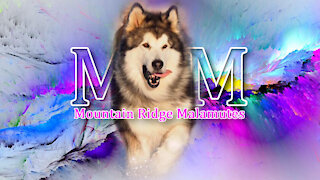 0:17
0:17
Mtnridgemals
4 years agoAlaskan Malamute Puppy
2122 -
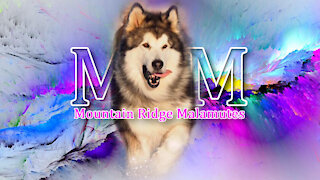 0:06
0:06
Mtnridgemals
4 years agoGiant Alaskan Malamute
288 -
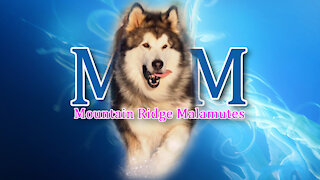 1:05
1:05
Mtnridgemals
4 years ago $0.03 earnedAlaskan Malamute Puppies Playing
1432 -
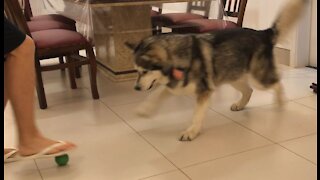 0:14
0:14
MidnightTomcat
4 years agoAlaskan Malamute playing with a ball
177 -
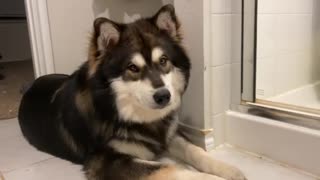 0:36
0:36
jravago
4 years agoAlaskan Malamute: Innocent look.
34 -
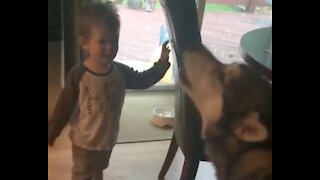 0:33
0:33
kwoodruff
5 years ago $0.89 earnedHowling Competition Between Toddler And His Malamute Buddy
5.84K -
 4:49
4:49
BOOKS, BOOKS, BOOKS
4 years agoTHE OTHER PEOPLE by C. J. Tudor
50 -
 9:11
9:11
PaintTheTrump
4 years ago $0.85 earnedPainting Trump and other miscellaneous people
4.15K29 -
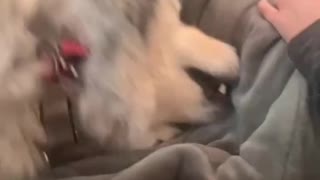 0:08
0:08
ViralHog
4 years ago $0.18 earnedAlaskan Malamute Learns He's Adopted
1.76K -
 1:18
1:18
Frogfrog
4 years agoBull challenge each other
401